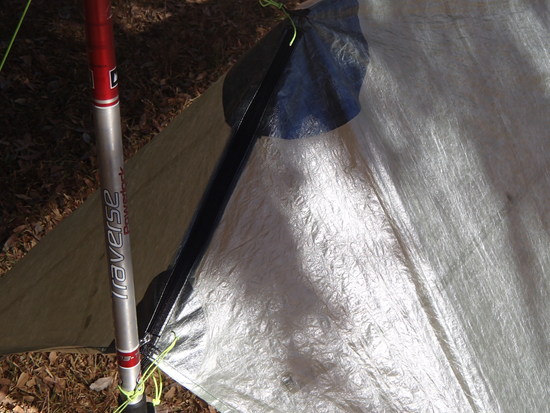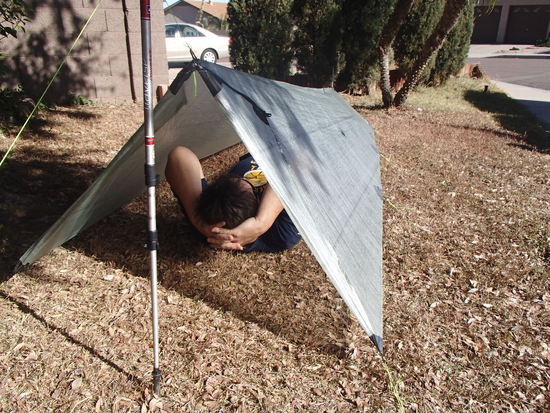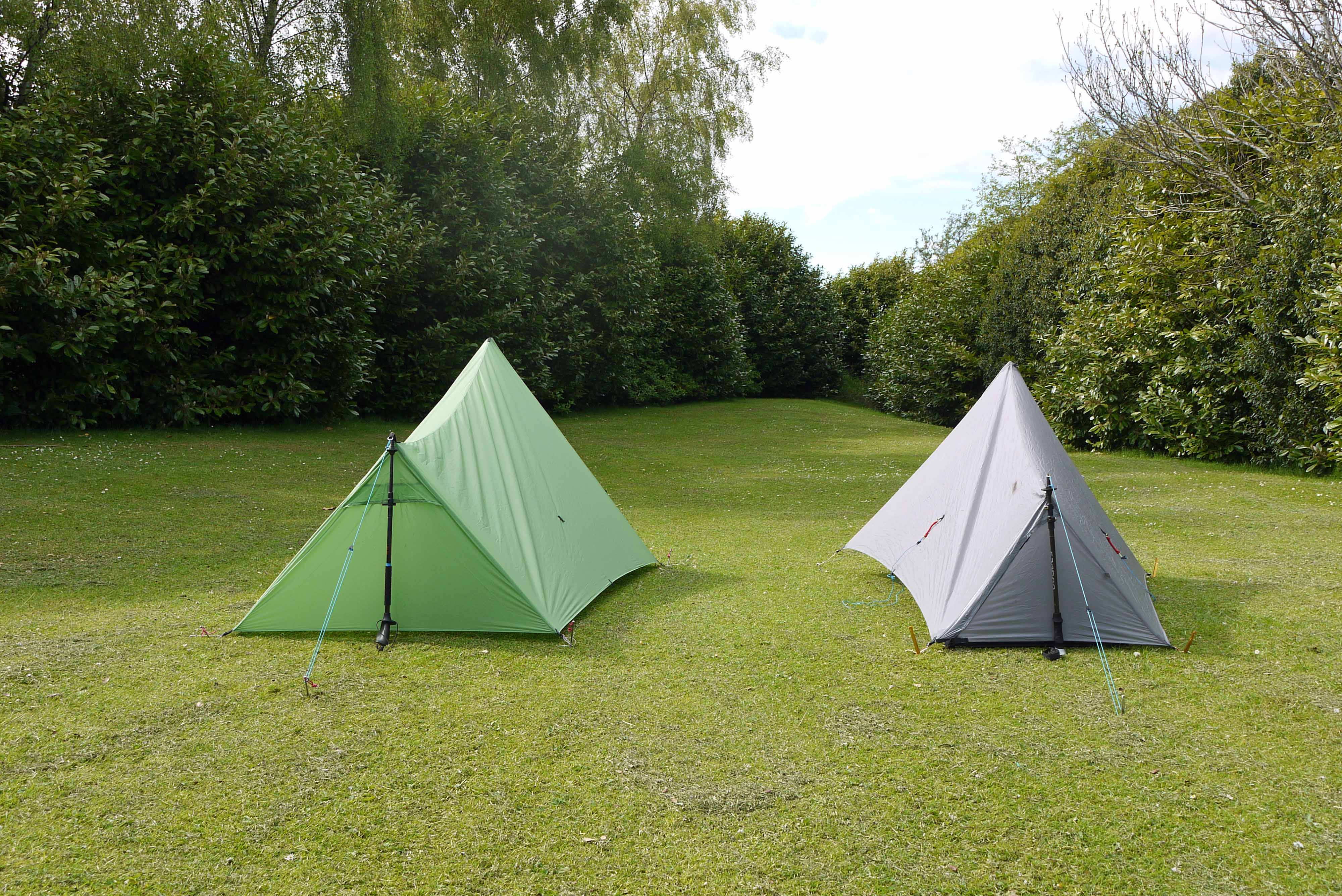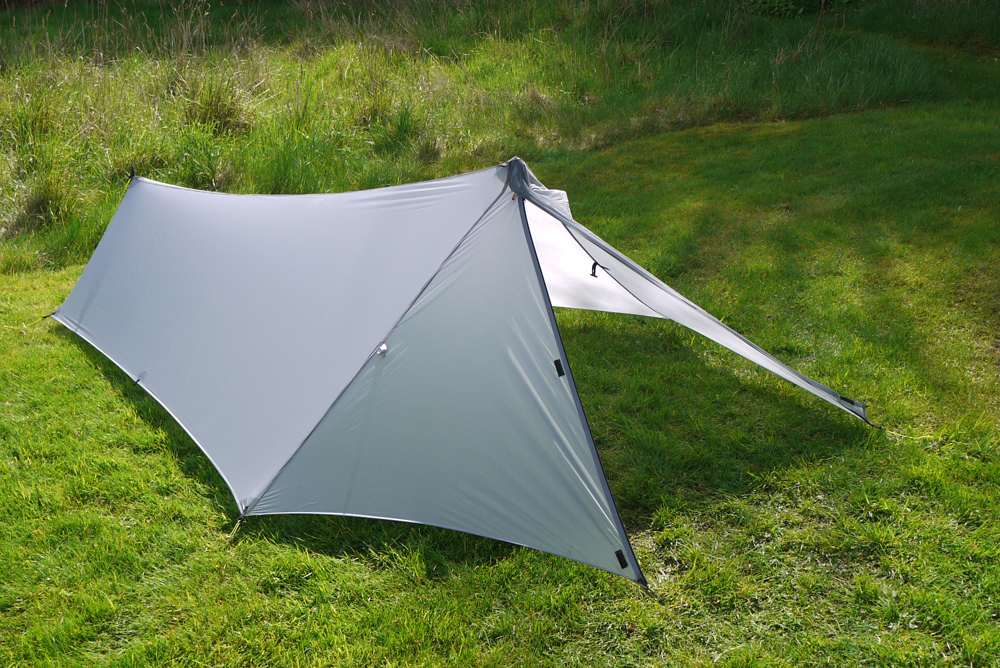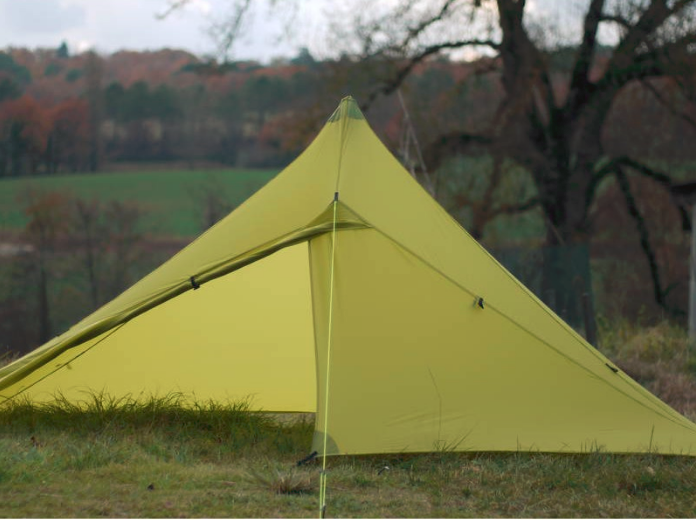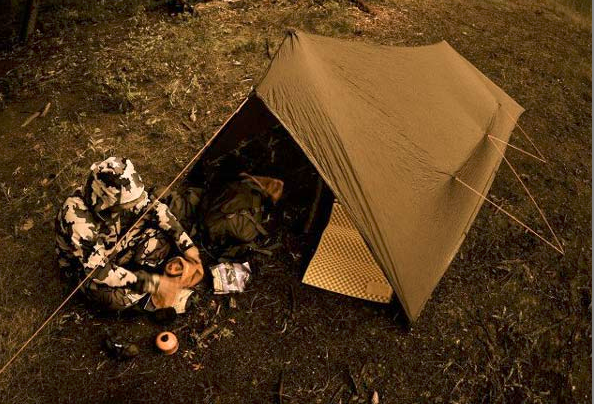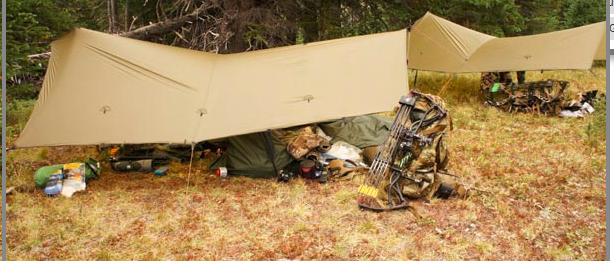Topic
MLD Patrol Shelter: can it be improved?
Forum Posting
A Membership is required to post in the forums. Login or become a member to post in the member forums!
Home › Forums › Gear Forums › Gear (General) › MLD Patrol Shelter: can it be improved?
- This topic has 22 replies, 12 voices, and was last updated 6 years, 5 months ago by
 Nicolas.
Nicolas.
-
AuthorPosts
-
Apr 10, 2018 at 4:21 pm #3529818
Please see below
Apr 10, 2018 at 4:23 pm #3529819Hi folks
Been playing around with A-Frame designs for some time now, but for my usage I haven’t come up with anything that would work any better than the classic Patrol.
Tight budget, so I’m planning to make my own. So I’d appreciate feedback from current users about any possible design tweaks.
1) PEGGING: I often camp in windy and exposed conditions. Is there any case for 2 pegging points per side as against the single point on the standard design? I don’t mind the extra weight if it would reduce flapping and panel distortion.
2) DIMENSIONS: I’ll generally be using a nest or bivy with a bit of splash protection, so is the standard design large enough to keep things dry in driven rain, or is there a case for making it slightly wider? Also, how high do you set the apex for storm mode? Do you think that’s about right, or is there a case for a higher or lower apex?
3) CUT: Any info you could offer about the depth of the cat cut on the ridge and the sides would be very helpful.
4) USAGE TIPS: any suggestions about living in the Patrol for long hikes would be very welcome. In particular – what do you do with wet rain-gear?
Thanks in advance for any responses…
Apr 11, 2018 at 5:17 pm #3529991- I vote for three peg points on each side. You may usually only use just the one most of the time, but be glad you had them all when you have to sit out that gale force wind. I am always a fan of extra tie-outs. I even order and pay for extra tie-outs when that is an option. You may rarely need them, but they are well worth the extra money and few grams of weight when you do.
2. I find the standard size to be good for me. It is hard to get in and out when you have to pitch in storm mode and it does get claustrophobic. I could see more square footage for the comfort factor, but that does add weight.
3. The cat on the Patrol seems to be designed for the average pitch angle. The cut is not optimum for narrower or wider pitches, but I consider it a good compromise.
4. I have a ridge line running under the apex of mine with mini carabiners. This allows me to attach my bug net, wet clothes and other items that I want off the ground.
I find have to unhook the corner tie-out to get in and out. I use a loop tied on the line for the corner that use to enter/exit from. This is to allow me to easily disconnect and reconnect the line when getting in and out. No knot to fiddle with.
Apr 11, 2018 at 6:20 pm #3530000I thought the second iteration of the Gossamer Gear Spinnshelter was a better design than the MLD Patrol Shelter so that may provide some inspiration. I liked being able to fold both the head and foot doors open and use like a tarp in nice weather, and with the door you aren’t crawling underneath the beak.
Apr 11, 2018 at 6:58 pm #3530008I agree with Roger about the now discontinued Spinnshelter. Having the ability to fully close the ends for extreme conditions and roll up when not needed was a great design. I never could figure out why they discontinued it and why nobody else picked up on it?
Apr 11, 2018 at 7:53 pm #3530018I believe the two person Patrol is the more practical shelter, with very little weight gain. You might also consider the Yama Mountain Gear Cirriform tarp, in either the 1P or 1P+ version, as it has a full front vestibule.
Apr 11, 2018 at 8:11 pm #3530024“I liked being able to fold both the head and foot doors open and use like a tarp in nice weather, and with the door you aren’t crawling underneath the beak.”
You can sort of do this with a hammock tarp that has ‘doors’.
“and with the door you aren’t crawling underneath the beak.”
Didn’t somebody make a patrol shelter with a zipper in front instead of a solid beak? Seems I remember that on BPL some time ago.
Apr 11, 2018 at 8:38 pm #3530033About 4 years ago I had Joe at ZPacks make me a tarp with a zippered beak. Wouldn’t be a real hard DIY modification.
t

Here it is opened up with the flaps secured to the sides. This is a tapered tarp, but you could do it to both ends of a Patrol Tarp. Would provide way more versatility..
 Apr 13, 2018 at 12:56 am #3530249
Apr 13, 2018 at 12:56 am #3530249Hi folks – very useful responses!
As a minimalist at heart I find the zipless simplicity of the Patrol appealing, but it seems that even people who like it see advantages in a zipped porch for flexibility, coverage and ease of entrance. And I’ve also had a couple of PMs saying pretty much the same thing.
So I probably need to be more pragmatic and go for a zipped design, even if it’s less aesthetically pleasing. I guess it will be reliable enough for thru-hikes if I look after the zips.
I’ve been kicking ideas around for months now, and here’s how I’m beginning to see it. Feedback would be welcome.
My primary issue is storm-worthiness. It’s pretty easy to design an A-frame for clement weather, but something light that will stand up to strong wind and driven rain is much more challenging.
Option 1: designing for strength
My first idea was based on the mountain tents I was using in Scotland in the ’60s. This is a fixed design hardened with A poles, side wings and the like. I started a mega thread where a lot of very experienced people drew on old and new designs to try and solve this, but in the end everything we came up with was too complex and heavy for my requirements. A dead end, for a summer tent at least.
Option 2: designing for variable height
For a lightweight solution, Ray Jardine’s idea seems more promising. Design something that’s liveable and well vented for clement weather, but which can be dropped low to ride out the occasional storm. I’ve been experimenting, and with the ground effect lowering the fly really does make a significant difference. This is trivial with an open-ended tarp like the MLD Grace Solo, but becomes more of a design challenge once you add porches.
One solution is the Yama Cirriform:

Designed for US conditions, it’s optimised for an airy pitch with the fly well off the ground. This means that you need a pretty protective insert or bivy to fend of splashback. In severe weather, you can pitch the fly to the ground and you have a defensible space that’s just about bearable. In good weather you can open up the front, The rear is porched but zipless..
Another approach is the TrekkerTent Stealth series.

Designed for Scottish conditions, the default pitch is fly-to-the-ground. In fair weather, you can lift the fly a bit off the ground, and in life-threatening conditions you can widen the front and drop it low. But unlike the Yama, this changes the geometry and you lose the enclosed front porch. The rear is flat, and with an optional zip you can roll it back, but then there’s no beak for protection.
Both good products, but perhaps there’s a better way. The ideal solution would offer:
- A high, well vented pitch for hot weather.
- A down-to-the-ground pitch that offered good living space for average wind and rain.
- A low pitch for riding out apocalyptic weather, prioritising safety over livability. This shouldn’t alter the porch geometry significantly, so you still get full coverage.
I haven’t see a commercial solution that offers all 3. I’ve been stuck for months, but I think that you guys have sparked an idea for a workable solution. There’s a feature I picked up from the Seek Outside Silvertip Tipi (a great bad-weather design – well worth checking out) that might offer a way forward.
They came up with the technique of putting side guy points a few inches up the fly rather than on the hem, so you can get a really good stretch on the fabric and seal the bottom with a kind of sod cloth. Extending this idea, you could have some kind of simple daisy-chain type attachment on the fly which would allow you to quickly move the guys higher on the fly and lower the apex, with the same geometry and a nice sod cloth seal to keep out wind, dust and snow. This way you get the 3 pitches for fair, poor and dangerous weather in a simple and failproof way.
Steven’s idea of 3 side guys would fit very well with this. The two outer guy points could be higher up the fly, and only used in locked-down mode. The center side guy would offer both the high and the low options.
This would be much more flexible than the Patrol, with setups ranging from a fully open A tarp with both porches rolled up, to a fully locked down storm pitch with sealed sides and full coverage. Plus it would be fun to make something relatively original rather than a near-clone.
The key will be in the detail of the porch design, to offer the widest choice of configurations while maintaining a tight pitch, but that’s another topic.
What do people think? Is this a viable way to go? I’ve been experiencing paralysis by analysis. I need to unstick this project and get sewing, but cash is tight and I also need to get something usable with the first iteration or two…
Apr 13, 2018 at 6:44 am #3530263Geoff
I know you seem keen on the A frame design, but have you used side entry mid type setups much? For access and liveability I find them better.
I had a Spinnaker Patrol Shelter some years ago, and also made a Rayway Tarp. Didn’t really get on with either for long. Ok for occasional use or good weather, but I much prefer a side loader.
I find non fixed A frames fiddler and slower to get a decent pitch.
The ‘porch’ on a Patrol shelter is minimal in comparison, as is sitting up room . (Unless pitched high).
If not keen on zips, you have such simple but weather-worthy designs as the MLD Cricket, Trailstar, Tipik Pioulou (https://tipik-tentes.fr/abris_tarps/pioulou).
Also, given your location, there are sources of interaction closer to home which could be useful:
E.g. http://trek-lite.com/index.php?forums/diy-myog.28/
Several DIY shelter makers there.
And last month on Dartmoor there was a show and tell (gear geektype) gathering where various backpackers brought their tarps and tents to the Fox n Hounds Hotel camp site. There will likely be another. You may have got useful design/construction tips from some of the shelters there. Nothing better than seeing things in the flesh. There were MLD, Tarptent (4 of mine alone!) , Six Moons Designs, Luxe Outdoor models on display, as well as more traditional tents.
Also, if in UK plenty of folk are happy to meet ( online or for real) and show their designs – whether bought or DIY. The recent meet showed there are dozens in Devon alone.
Hope this is useful.
Mole
Apr 13, 2018 at 11:34 am #3530268I am primarily a hammock hanger, but I do hike locations where finding a place to hang a hammock is a problem and for those times I will always bring the Patrol shelter with a bathtub bug net to hang from the inside hooks..
I do not like zippers on my shelters any more. I have had too many fail. The heavier zippers are much more reliable, but are heavy. Velcro is better, but that can get fouled in dusty environments and Velcro wears out
I like the reliability of a shelter with no fiddly bits that wear out.
I do enter the shelter from the side most of the time, except maybe when pitched hi for warm dry climates. Not difficult at all with some practice.
I enter by unhooking the corner tie. You can do this in the rain without getting the inside wet with a little practice.
One of the issues with many shelters is that you often get water on the inside when entering through the zippered entrance.
The Patrol is the most flexible shelter I have ever owned.
It can be pitched to accommodate weather extremes.
Pitched high allows a good air flow for hot climates.
Pitched to ground with only a gap at the beak, with all tie-outs secured, allows for a dry warm night in the most extreme wind and rain/snow. Of course the beak should be a few inches off the ground or you could suffocate.
The Patrol sheds wind better than most shelters when pitched this way.
I have had situations where I was the only hiker that didn’t have to deal with shelter problems during extreme wind and rain.
Another thing to consider about the size is that the the Patrol can fit into tight locations better than most shelters. I know I have had many cases where there just wasn’t much open ground to pitch a shelter and not requiring a large footprint was important.
I often dreamed of getting the larger Patrol, but then I think about the increased footprint and/or increase height in the wind.
I have had people complain about the Patrol being too minimal, not enough shelter, but I feel it was from people that didn’t learn tarp camping and so didn’t pitch properly for their situation.
I feel the Patrol takes longer to learn than most shelters, but with experience can go anywhere.
By the way, I have owned way too many shelters and would often prefer a tarp over other designs because of the flexibility. So my opinion is based on my comfort with tarps.
Some people can not and will not really learn tarp camping and they should probably stay away from the Patrol.
Apr 13, 2018 at 2:19 pm #3530278The Spinn Shelter was made to be raised up off the ground in nicer weather or staked directly to the ground for bad weather and it did not use a zipper on the front vestibule or back that could be opened for ventilation. I really like my Spinn Shelter I just don’t like the material they used to make it, it was too fragile and prone to leaking. I emailed Gossamer Gear a number of months ago and asked if they had any intention of bringing it back with better-updated materials and they said that they had been looking into it but didn’t know when.
Apr 13, 2018 at 4:14 pm #3530287Mole – well, let’s not get into the whole side vs front loader thing as that’s a rather different issue. I’ve been using A frames and tunnels for over half a century, so I guess I’m pretty familiar with the pros and cons.
But I do share your dislike of zips, as they seem to be the main cause of shelter failure, especially in dusty areas. Even on Hillies with daily maintenance. Which accounts in part for my preference for tarps (my main shelter is a TrailStar). That sobering Hillie thread has made me re-evaluate yesterday’s idea that I might switch to a zipped design – I really do need to find a zipless solution.
Thanks for the link to the Tipik Pioulou – interesting new venture. They have a clever design for the peak that I might be able to use to get full coverage in a Patrol-style shelter without resorting to a zip. I’d been groping towards something like that myself, that combines the advantages of a peak and a vestibule. But it’s nice to see it working on well-tested product.
I do drop into Trek-Lite from time to time, but for MYOG the expertise here is unmatched (and international – Roger the moderator is Australian, for example). I missed out on the Dartmoor meetup – do you have a contact for the organiser in case they do it again?
Steven – exceptionally useful – much appreciated.
For wind, I agree that the main advantage of tarps is flexibility. As I said above, even a small fixed-shape lightweight A-Frame would need a lot of hardening to deal with big winds, adding unacceptable weight and complexity. And it’s also going to be stuffy in heat. So the most viable lightweight solution is a design like the Patrol that you can drop down into storm mode and pitch high when it’s hot. Given that I like to camp high I’d be pushing things to the limit, so it’s very reassuring to hear that the Patrol has been reliable for you in big storms.
As for space – like you my style is pretty much walk and sleep and I’m prioritising a small footprint for Alpine treks. So it’s very useful to know that you find the coverage adequate with a protective insert, even if it is a little claustrophobic at times. I walk in all weathers and am rarely storm-bound, so I can live with that. My TrailStar is great for open moorland, but the the footprint is literally 3 times the size of the Solo Patrol, which also means it’s relatively heavy and bulky.
So I’m firming up on the idea that I should build something based on the Solo Patrol. But I really would like to add the capability for a high, medium and low pitch as described in my last post, rather than the high and low offered by the Patrol. This would require a bit more fabric, but the added weight would be minimal, especially if I can avoid zips. With the Patrol in Scottish/Scandi conditions I’d just be spending too much time in storm mode, which may account for the fact that people here prefer the TrailStar, which is pretty livable in its default wind-shedding pitch.
I’m going to play with the Tipik hybrid peak/door design. It may give me a way forward:

 Apr 13, 2018 at 4:39 pm #3530292
Apr 13, 2018 at 4:39 pm #3530292PS – Steven –
Do you know what pole length you use in storm mode? It would help me figure out the Patrol geometry.
Apr 13, 2018 at 5:26 pm #3530301I do not know what pole size I use in storm mode and in fact it’s never consistent depending on what compromise I chose regarding regarding internal volume and storm-proofness.
Regarding the Trailstar, I have always been torn between it and the Patrol. Both are very wind proof, have flexible pitch options and zipperless.
The Trailstar may be more of a pyramid style, but the Patrol is somewhat as well. Although the Patrol is considered an a-frame because of it’s shape, it has a similar setup.
Apr 13, 2018 at 11:39 pm #3530381Steven
On the Patrol vs the TrailStar…
The TrailStar is truly bomber – in a 40 mph wind on Dartmoor the loudest noise is the deergrass rubbing against the hem. I’ve never had it anywhere near its limit in about 90 days of use in the UK and the Alps. The open entry gives great views and is very well protected. I carry a cuben screen for the doorin case the wind swings and it works well – I’ve never had to re-pitch. And it is, IMHO, the most beautiful tarp even made and looks great in pics.
BUT.
The footprint is HUGE, as we’ve discussed. Quite tricky in the Alps, and all that fabric means its quite heavy and bulky. And with the shallow walls most of the inner space is unusable – its surprisingly tight, especially in storm pitch. You have to crawl quite a distance over wet and often dung-strewn grass or mud to get inside. Rigging up insect protection is a pain, because of the central pole – it doesn’t play well with nests. And it’s quite a tricky pitch when it’s wet and windy and dark at the end of a tiring day – especially as the footprint means you’re often improvising around slopes or logs or rocks or bushes or clumps of grass. Quite odd having a bush INSIDE your shelter…
The Patrol won’t be quite so good in the wind, though probably good enough with a good pitch, as you’ve said. But it will be much easier to find pitches, and the inside is more human-shaped, so nests will work better and there’s much more space above your head, which I like. It will be lighter (much lighter in cuben – the TrailStar only really works in sil). And it will take up less space in your pack.
You pays your $$$ and you makes your choice…
Aug 12, 2018 at 5:08 am #3551034If anyone is interested in the Pioulou, I have one and happy to answer any questions and/or meet up and pitch it. I am based near Dartmoor currently.
Here are my first impressions of the shelter and some pics, pitched and packed with weights.
http://www.idontdoohills.co.uk/piouloufirstimpressions/ATB
Aug 23, 2018 at 2:52 pm #3552721Geoff,
I am thinking about a similar design and I may have found a zipper-less solution: You place the two sides of the beak next to each other like it would be the case with a zipper but with a bit of overlap. Now you place (sewed onto tarp) a triangle shaped piece of tarp fabric over the overlapping section. This triangle begins wide where the sleeper (the human or whatever is sleeping under the tarp) is and tapers off towards the end near the (trekking) pole. The tip of the triangle ends where the tips of the two sides end as well. Each of the three pieces (the two sides and the triangle) have a tie out on their ends. The lowest fabric piece of the three (i.e. the lower of the two sides) is tied out to the pole separately while the two upper pieces are tied out with the same guy line. A clip is used for both guy lines in order to quickly unclip when you want to get out. You only have to unclip the lower side in order to open the “door” on one side which should be enough to get out. Of course you can undo the whole thing, tie it back and not have a beak at all.
I am curious whether somebody can find a flaw in my design attempt to create a zipper-less but non-permanent beak.
For clarity: Whenever I said “side” I mean was referring to the side of the beak.
Aug 23, 2018 at 3:44 pm #3552731Another zipper-less door idea – Have you thought about just making the beak/door solid with no zippers/overlaps/etc and optimizing the geometry such that you can lift the tip of the beak up and back to enter and exit? In other words, make the triangular “base” of the deployed beak the same shape as the profile of the A-frame. It could potentially work well the the 3-pitch idea, just put another daisy chain on the end of the beak to maintain optimum geometry at the 3 pitch heights.
The only shelters I can think of that have something like this are some of the Tramplite shelters. Side entry of course, but I think the same principle could possibly be applied to an A-Frame. Might result in a longer than needed beak for optimal geometry, but that could also be advantageous from a livability perspective, especially in nasty weather.
I’m really not sure it would work in practical application, but I’ve often wondered about an entry like this. It seems like it might be a bit limited in versatility – might be hard to have the door partly open, and the extra fabric when open would be something to manage. But I also think it could provide a very solid pitch with minimal threat of failure if the geometry was right.
Aug 23, 2018 at 6:20 pm #3552753Hi guys
Thanks for the suggestions. Nicolas – I’m not clear where your idea would improve on the rather nice Tipik design I posted above. What do you see as the advantages? Can you post a sketch?
My thinking has moved on a bit. At the moment, I’ve pretty much settled on a design that is inspired by the Kifaru Paratarp/SuperTarp for the body and the Tramplite 3/4 design for the beak. I’ve not been in any rush, as I’ve had commitments that have kept me off the long trails. After an extended gestation, I’ve finally come up with something that seems to tick all the boxes on my rather challenging wish list.



The Kifaru design gives a very taut and stable body to the tarp. There is no separate rear panel – it’s formed by stretching the fabric over the pole which keeps it under good tension. Kifaru claim that extensive use in Alaska has proven it will handle 60 mph+ winds, and reviewers agree. You can peg the rear to the ground or leave it as an open A-frame with good coverage when you want the ventilation and views. You can get a very stable pitch with just five pegs for normal weather, or add side-guys and additional pegs to make it absolutely bomber when things turn nasty.For the beak, I’ve played with a couple of zipless ideas using paper models, but they seem to add complexity to the cut for the overlap and require an extra peg for closure. They also seem like a bit more faff in use, and there is potential for the overlap to flap in the wind. I suspect that I’m over-thinking this zipless issue – I’ve personally never had a zip failure in 50 years of camping, and looking more carefully at posts by people who report problems, they are mostly using long, curved zips. My design will have a very short, straight zip, and I can over-engineer it with a YKK #5 for a negligible weight penalty. In return for the slight loss of reliability, I get a simpler and more flexible design that’s easier to pitch and use.
Here’s Colin’s Tramplite with the 3/4 beak – the version he uses himself. He’s a very smart designer and it’s difficult to see how it could be improved. Note that you can roll back the doors and still have good tension from front to back. It’s also easy to tension the doors from the inside. Other MYOGers have been copying this arrangement and seem to like it. If you favour side entry and can handle his prices and waiting list, the Tramplite looks like a superb and elegant shelter.


I’m pretty confident that this design will give me a flexible and storm-proof tarp for 3.5 season use in exposed places.In good weather I can pitch it in moments as an open A-frame tarp, with an open foot and the beak rolled back leaving a slight overhang at the front for drip protection.
In normal European weather I can pitch it high or low as a near-enclosed tarp-tent that gives good privacy with decent venting and excellent storm protection.
And in apocalyptic weather, I’ve designed the beak so that I can drop the front pole with the hems to the ground to make a low-profile survival bivy.
Finally, as an A-Frame, it plays well with nests while retaining excellent clearance for head and feet.
Here’s the design in normal and survival pitch:

I’ll do a full write-up when I can make the time to actually prototype the thing. Meanwhile, any suggestions for improvements would be welcome.
Aug 23, 2018 at 10:09 pm #3552778Personally I’d take the TT Notch Lithium. I like the shape of the interior space.
Aug 24, 2018 at 7:27 pm #3552901Geoff,
my overall design isn’t too different from yours. This particular split beak design allows for a more extreme ventilation mode when preventing condensation is the primary goal and there is little wind. The fabric which makes up the “split beak” can either be set up as an extension of the ridge line (resulting in a “normal” shaped (lower and less wide in the rear than in the front), catenary cut tarp) for conditions with low wind speeds or it can be set up as a beak for stronger winds. In the apocalyptic scenario the rear can also be tied down to the ground completely. In summary: a split beak with a triangle to cover the gap provides variability for a wider range of weather conditions.
I have looked at the Tipik pyramid design. The idea is similar in that it also has two overlapping elements (the doors) which are covered by fabric. The difference is that the covering fabric with the Tipik is not shaped like a triangle but is a beak itself which is fixed and does not allow for the transformation into an A-frame and also doesn’t allow to make the front width (below the beak) wider than when the beak is angled completely down which is probably not a practical issue in your case and is never an issue with a side entry design. The advantage of what I have proposed above is that you can – in contrast to the Tipik design – transform the patrol style shelter (=A frame tarp with beak) into an A frame tarp without a beak which gives you decent protection from rain because you have a good amount of overhang (overhang = horizontal distance between inner tent and end of tarp) while providing the maximum amount of ventilation possible. It is easy to design for maximum ventilation OR maximum rain / wind protection yet combining the two is challenging which is achieved here. If you always have high wind speeds this is not as useful of course but I guess even Scotland has some calm days ;-)
Design constraints: What I have in mind with the split beak above doesn’t work with shelters who have only one pole (pyramids). Will you have two poles? I can’t make that out from your sketch. It is also less useful if the height difference between front and rear pole is extreme because then the tarp’s front tie out point (the one that connects to the pole) would be too high above the inner tent which is wasting front pole length because you could use that front pole length also to elevate the tarp as a whole. to increase ventilation.
I will write up the details in a separate thread as that would distract too much from the topic you have set here.
————————
Erik,
i like the idea but I don’t see how this could work. I have cut a little paper model and when I pull up the beak as you suggested then there is strain on the lower sides of the beak (the ones which are not sewn to the tarp) which prohibits lifting the beak up. But maybe I haven’t understood you correctly. Maybe you can draw something?
Aug 31, 2018 at 10:06 pm #3554077Here is my design of a patrol style shelter with “on demand” beaks that I have mentioned above: https://backpackinglight.com/forums/topic/myog-around-the-world-shelter-design/#post-3554064
-
AuthorPosts
- You must be logged in to reply to this topic.
Forum Posting
A Membership is required to post in the forums. Login or become a member to post in the member forums!
HAPPENING RIGHT NOW (February 11-21, 2025) - Shop Hyperlite Mountain Gear's Biggest Sale of the Year:
Our Community Posts are Moderated
Backpacking Light community posts are moderated and here to foster helpful and positive discussions about lightweight backpacking. Please be mindful of our values and boundaries and review our Community Guidelines prior to posting.
Get the Newsletter
Gear Research & Discovery Tools
- Browse our curated Gear Shop
- See the latest Gear Deals and Sales
- Our Recommendations
- Search for Gear on Sale with the Gear Finder
- Used Gear Swap
- Member Gear Reviews and BPL Gear Review Articles
- Browse by Gear Type or Brand.

